Contents
Advertised by the well-known manufacturer and blogger San Sanych, the Medium SS-2 PRO distiller is constantly discussed on specialized forums. It’s time to deal with its characteristics in a separate review. On the one hand, the device has an average price for a bookmaker, on the other hand, rather exotic methods of working with this column are alarming buyers. Perhaps not in vain.
Tsarga
SS-2 PRO is equipped with a choice of 50 or 70 cm drawstrings. The first option will suit lovers of fortified moonshine, and the second has a minimum length to obtain a purified distillate. Drawer side diameter 38 mm, wall thickness 1,5 mm, material AISI 304.

The sides are sanded to a matte finish. The quality of the seams is quite decent in appearance, carefully polished on the outside, they completely merge with the material of the side.
But inside… Note that the photo is taken from the official site, and not picked up on the Internet. This means that from the point of view of the manufacturer, everything is in order here and demonstrates that the seams are welded through. With a “purging”, as San Sanych says.
Alas, it will have to upset him. GOST 30242-97 “Joint defects in metal fusion welding. Classification, designation and definitions”. It is obvious that there is a whole bunch of seam defects classified by GOST as group 5. These defects reduce strength and impair the appearance of the seam.
This refers to 504 – local excess of penetration, 509 – leakage, etc. Of course, you can’t reveal all the defects from the photo and it’s impossible to say that there are no other, more serious ones. In any case, such a tsarga cannot be a source of pride, and even more so an advertising photograph.
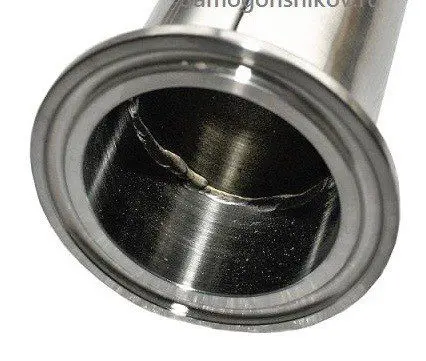
For those who want to improve the quality of the product, the manufacturer recommends purchasing additional drawers, which are produced in almost any length up to 1 meter inclusive in 10 cm increments.
Equipping the devices with an on-load tap changer in the basic configuration, the manufacturer does not hesitate to say that the taps are different. Each distiller for his tasks is free to choose what best suits them. SPN recommends as the best nozzle. Honest and fair.
Dephlegmator
You can choose from a jacketed or shell-and-tube dephlegmator.
Both are equipped with water inlet and outlet pipes with ½ inch threads, overall length 20 cm, working length 16 cm. Inside the shell and tube there are 5 heat exchange tubes with an inner diameter of 8 mm and a thickness of 1 mm.

The quality of the welds and their processing are at their best, here you can feel the work of real specialists.
A shirt reflux condenser in combination with a tsarga with an inner diameter of 35 mm has the right to life as part of a distiller with reinforcement. The utilization power of the jacketed reflux condenser is about 1150 watts. When working with SPN, this is enough for the column to work for itself at pre-choke capacity. There will be no steam breakthroughs, which will allow you to select the “heads” and “body” without any problems.
Together with the RPN, you will have to perform dances with tambourines.
When the column is working on itself, the most acceptable option is to turn the refrigerator over. And when selecting “heads” to return it to its place. Whether it will be possible to organize a drop-by-drop selection depends on the density of the tap changer wad. It is much better to use the optional head and tail selection unit. But more on that later…
Another option is the selection of “heads” at reduced power. The separation capacity of the packing will be significantly lower, so it is unlikely that it will be possible to select the head fraction qualitatively. This option is only suitable for obtaining fortified moonshine. For serious purification of distillate from sugar raw materials to the level of alcohol, it is unacceptable.
For lovers of good distillate purification, the manufacturer offers a shell-and-tube reflux condenser capable of utilizing up to 1600 W in nominal mode. It seems that the issue has been resolved, but … As always, everything is spoiled by the speed of the steam.
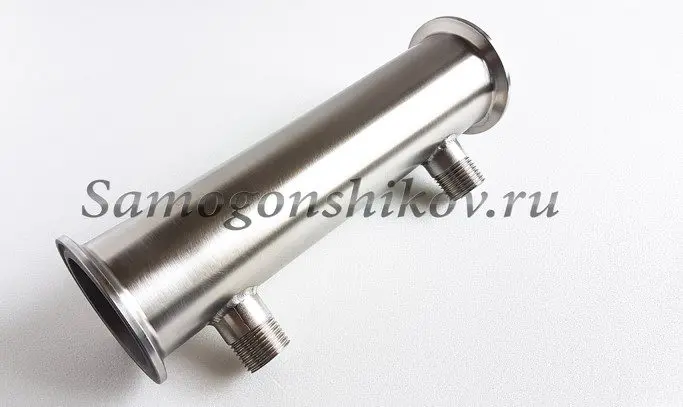
When using SPN, the operating power of the column is about 960 watts. In this case, the steam velocity in the dephlegmator will not exceed 2,8 m/s. A little high, but within reason. With SPN it will be possible to work according to the standard technology for BC. But in the case of an on-load tap-changer, in order to achieve maximum separating power, it will be necessary to increase the heating power to about 1200 watts. The steam speed will be about 3,6 m/s. It’s already a lot.
When working for yourself and even when selecting heads, problems will begin with slowing down phlegm at the outlet of the reflux condenser, drops will start to be driven up by steam up the tubes, conditions will be created for the upper choke. And happiness was so close: it would be worth putting 4 tubes of 12 mm or 12,5 mm, and that’s it … To work with the on-load tap-changer, you will have to dance in the same way as with a shirt reflux condenser, although the reasons are different.
After the reflux condenser, there are traditionally two 90-degree corner bends. One of them contains a sleeve for a thermometer, in a more modern version – a nipple.
Refrigerator
Older modifications came with a welded-in product outlet. The modern version ends with a clamp connection. Well, the spout is purchased separately and at will.
There are 5 steam tubes inside the refrigerator. External diameter – 8 mm, internal – 6 mm. There are 3 partitions. The length of the refrigerator is 34 cm, the working one is 30 cm.
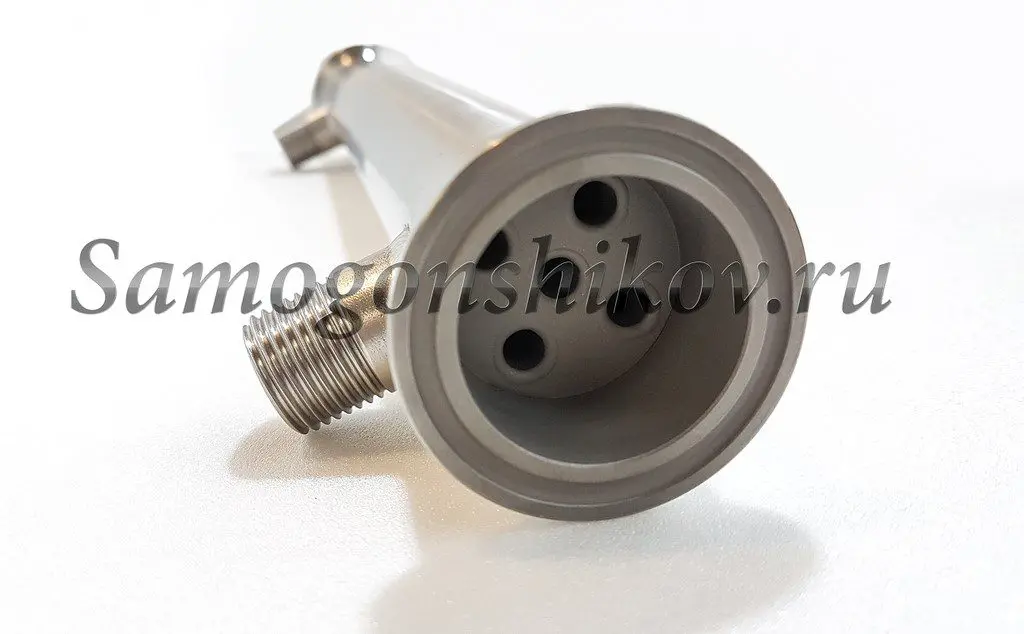
The rated utilization power of the refrigerator is about 2,3-2,5 kW. Productivity – about 4,5-5 l / h. It is quite acceptable for household needs.
Naturally, we are talking about useful power under standard design conditions. If the water temperature at the inlet is not 20, but 10 degrees, then more can be expected. It is true and vice versa: at 30 degrees at the entrance – God grant him good luck.
The spout of the refrigerator, highlighted in a separate part, is well made. I wanted to write what is standard, but compare for yourself: on the left – from San Sanych, on the right – the first analogue from the Internet that came across.
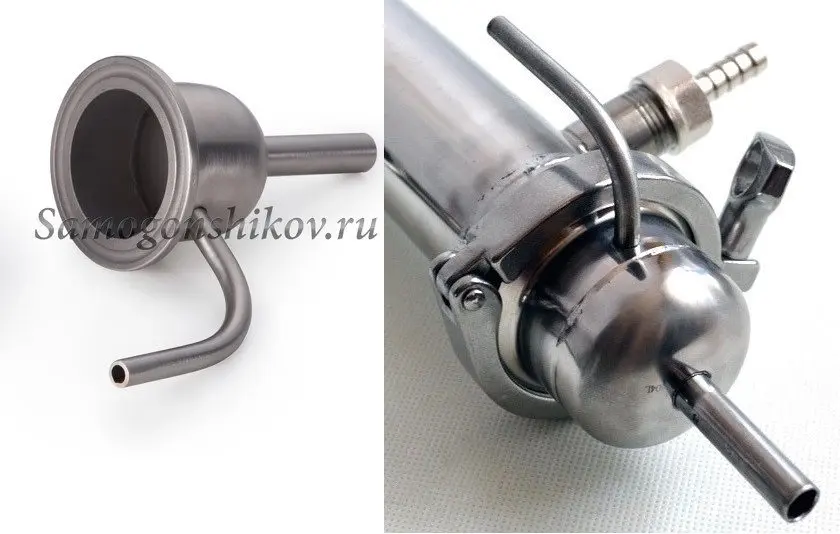
Obviously, different manufacturers have quite different ideas about the required level of quality.
Stills
Cubes are offered for purchase separately, without imposition in the kit. The tanks are made both on the basis of the well-loved Chinese LuxStahl pan, and on the basis of our own production of the CC series for 60 and 100 liters.
The range and list of additional options is very wide.
Cubes can be equipped with a nipple for a thermometer, clamp connections for a column and for a heating element, a stainless cock for draining stillage and a pressure relief valve.
The valve, unfortunately, is from a pressure cooker, its applicability to use in home brewing has been repeatedly discussed and condemned. But for alembics with rigid wing caps, such a valve makes some sense. For example, for cubes with a neck of 210 mm based on the LuxStahl and “SS” pans.
Indeed: it is difficult to imagine that these covers will be torn off before the valve works. True, we must not forget that, depending on the manufacturer, the valve response threshold can be from 1,2 to 4 atmospheres.
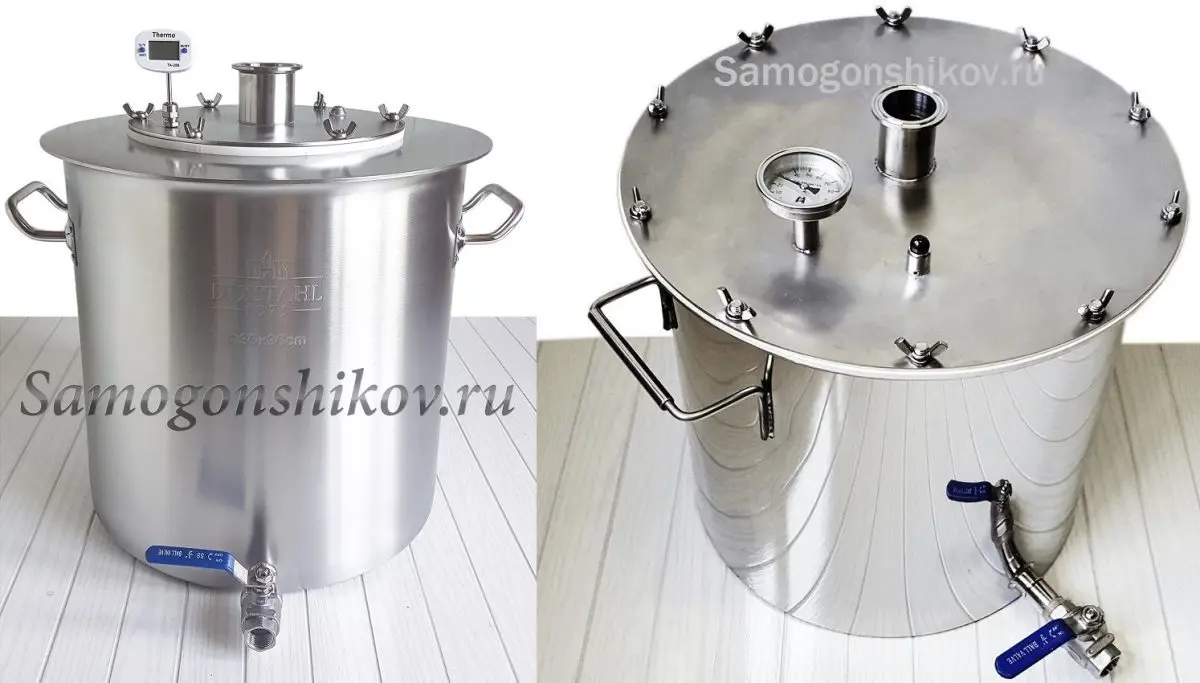
Therefore, you should not relax, this is a safety issue. Let me remind you: it’s not scary that the lid of the cube will be torn off or its individual parts will be damaged, the instantaneous depressurization of a boiling alcohol mixture under pressure above 0,5 atm is dangerous. This can lead to a volumetric explosion with serious consequences. Therefore, it is more correct to install a valve with a response threshold of not more than 0,1-0,2 atm.
For cubes with clamps, this is especially true. As the experiments of our colleagues show, the quality of the clamps is so unpredictable that even at 1-1,2 atmospheres they are torn off without a twinge of conscience. This does not mean that you should be afraid or avoid such cubes – on the contrary, they are very convenient. You just need to pay attention to the parameters of the safety valves and the material from which the clamps are made. Quite often there are offers of clamps made of thin galvanized steel, without adjustment of the tightening level with weak non-adjustable fasteners.
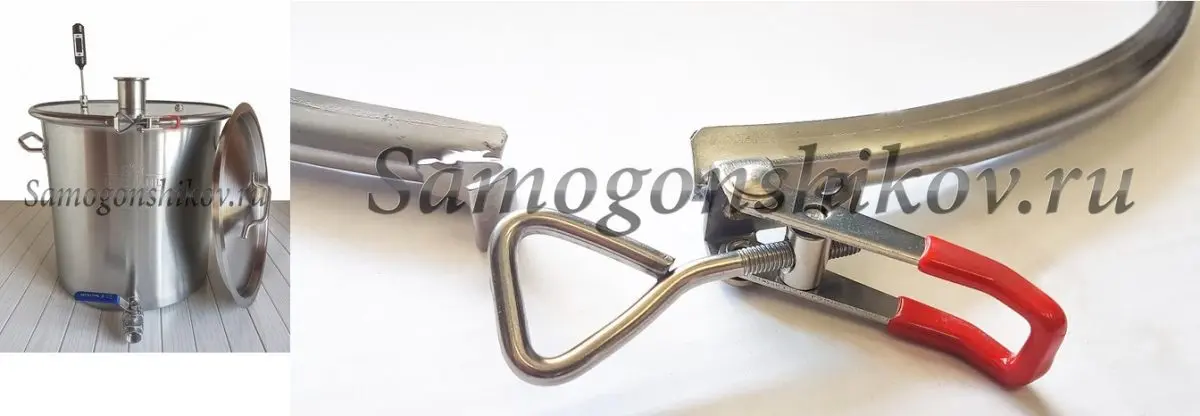
We must pay tribute to San Sanych, he approached the quality of the clamps responsibly. Made from stainless steel and equipped with a buckle with adjustable clamping force, the clamps meet today’s expectations of the required level of reliability.
But this does not eliminate the need to replace safety valves with more suitable ones for the specifics of home brewing.
The positive aspects of cubes from San Sanych include the trouble-free installation of additional equipment. It is possible to weld additional handles, a liquid level indicator, clamps for filling and (or) inspection necks or heating elements without any problems.
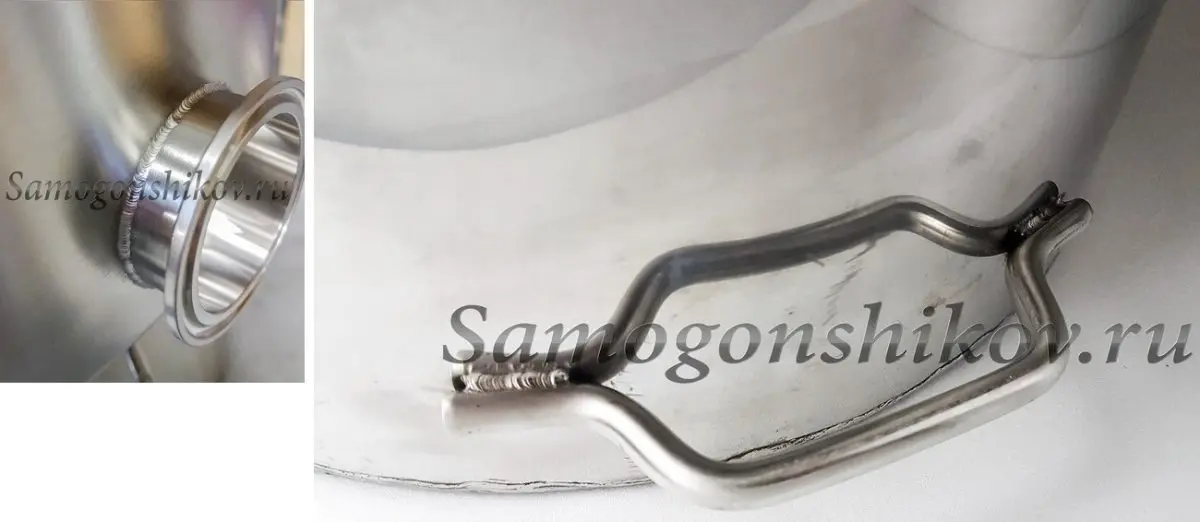
Against the background of converted cubes based on LuxStahl boilers, the SS series looks definitely rude. No wonder the manufacturer offers to take a closer look at the photo of welds and the quality of their processing when ordering. Cubes are made of AISI 430 stainless steel. This steel has the conclusion of the Department of State Sanitary and Epidemiological Surveillance on the possibility of using it in the food industry.
Yes, of course, the technology for the execution of cubes of the SS series has great prospects for improvement. But the honesty of the manufacturer is captivating, literally poking the buyer’s nose into all suspicious places and coordinating the subtle points.
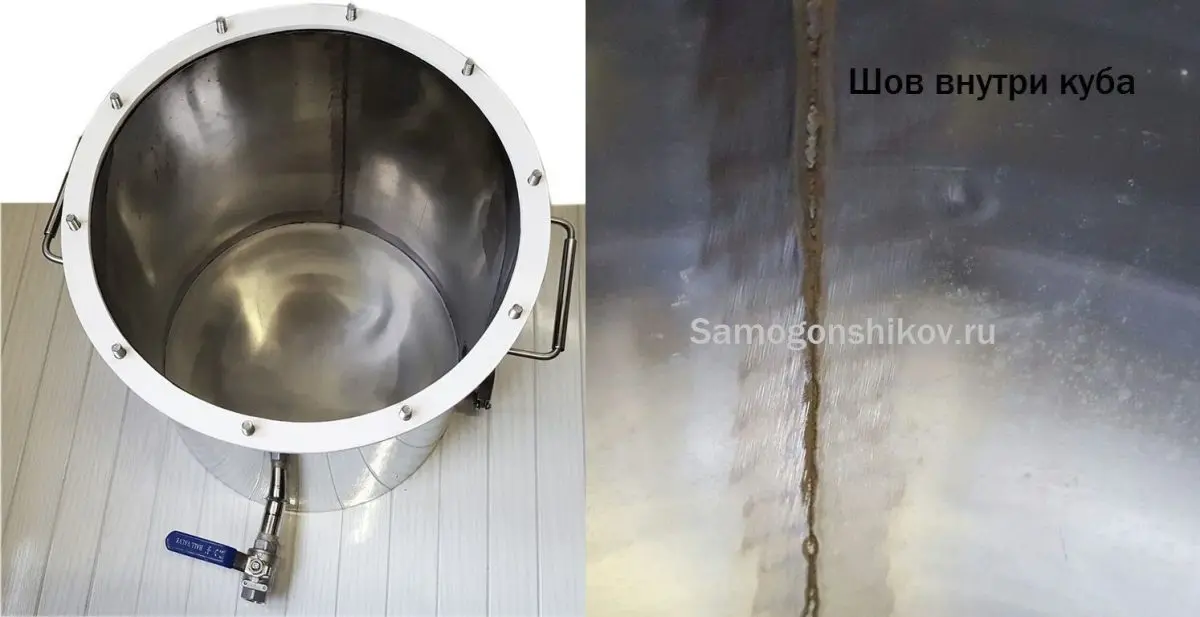
In general, the range of distillation cubes is quite large and varied. You can choose something according to your taste and budget.
Additional equipment
Node for selecting “heads” and “tails”
Among the knots offered in an additional complete set, the knot of selection of “heads” and “tails” deserves special attention. A small detail can greatly facilitate the task of selecting the upper fraction.
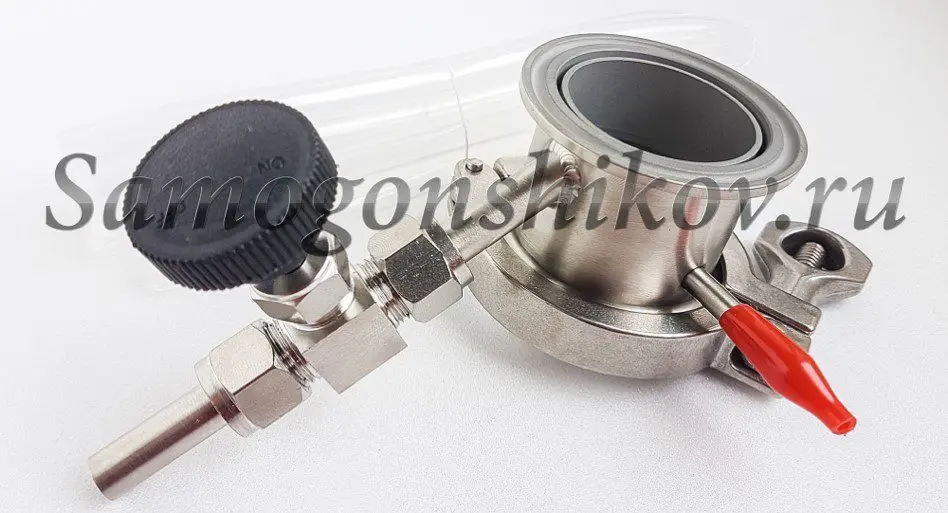
The manufacturer suggests placing this assembly immediately below the reflux condenser. But if you use the refrigerator as an additional condenser, then it makes sense to install it directly under the refrigerator. Adjust the reflux condenser so that it partially passes steam, and does not turn on the cooling at full power. The steam passing through the reflux condenser will already be saturated with volatile impurities due to heat and mass transfer in the packing. In the reflux condenser, the steam will pass through another two or three steps of strengthening and enter the refrigerator with more concentrated volatile impurities. And now, from the upper phlegm, it is already selected as the head fraction.
When selecting “tails”, this node is located directly between the column and the cube. Its ideal location, of course, is about 20 cm from the bottom of the nozzle, but even with this placement for short sides it gives a positive result. By removing some of the fusel oil during the distillation process, the “heads” and “tails” selection unit increases the column’s ability to retain heavy-boiling fractions. The only thing is that when distilling grain distillates, it can be harmful. It is known that the flavoring of cereals is contained in the pre-tail and even in the tail fractions, so it is completely wrong to put them out for waste. But here the solution is simple – control. Periodically, you need to smell the excreted liquid, as soon as it changes the smell to a pleasant grain, no one forbids simply turning off the tap or putting in a new container to collect heavy esters. And their fate will be determined later during the final blending of the drink.
In any case, the usefulness of this selection node and the promise of various experiments with it should be noted.
Power regulator
A digital power regulator is a useful thing, but for some reason it is based on the outdated RM-2. Competitors have long switched to more modern models RM-2-16A and RM-2-32A, which have active cooling of the triac and radiator using a built-in fan.
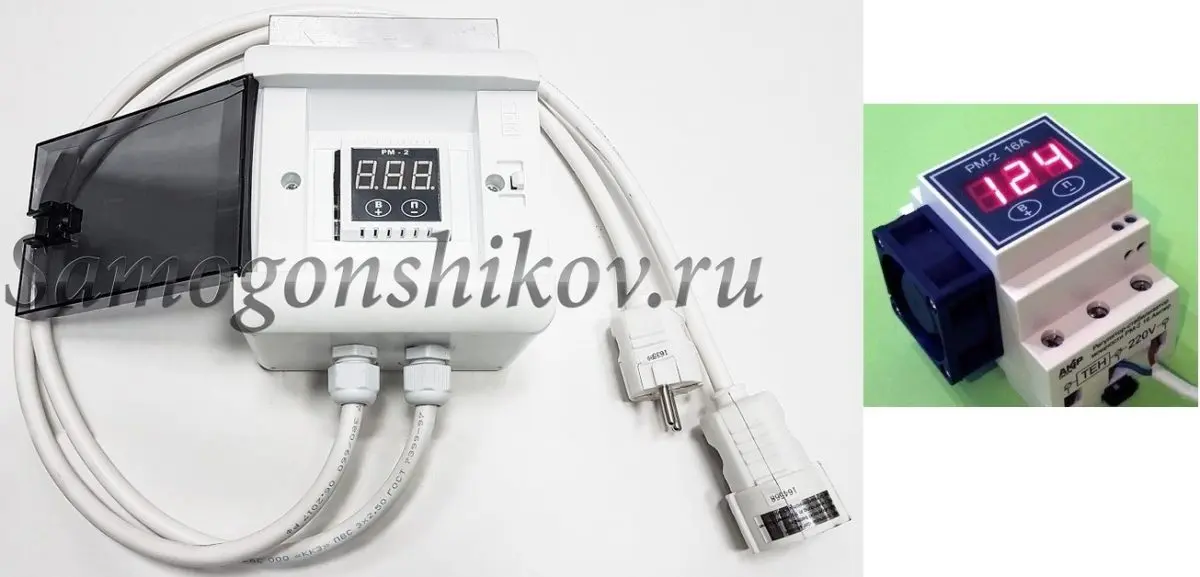
In addition, they equip the finished blocks with single-pole automatic machines and toggle switches, including the overclocking mode. The “overclocking mode” is used to ensure that the system quickly enters the technological operating mode, after which the power limitation is turned on. At the same time, the prices of analogues are not at all higher, and often even lower.
Aroma gin basket
This is a well thought out and made knot, one of the best on the market. Impeccable workmanship deserves respect.
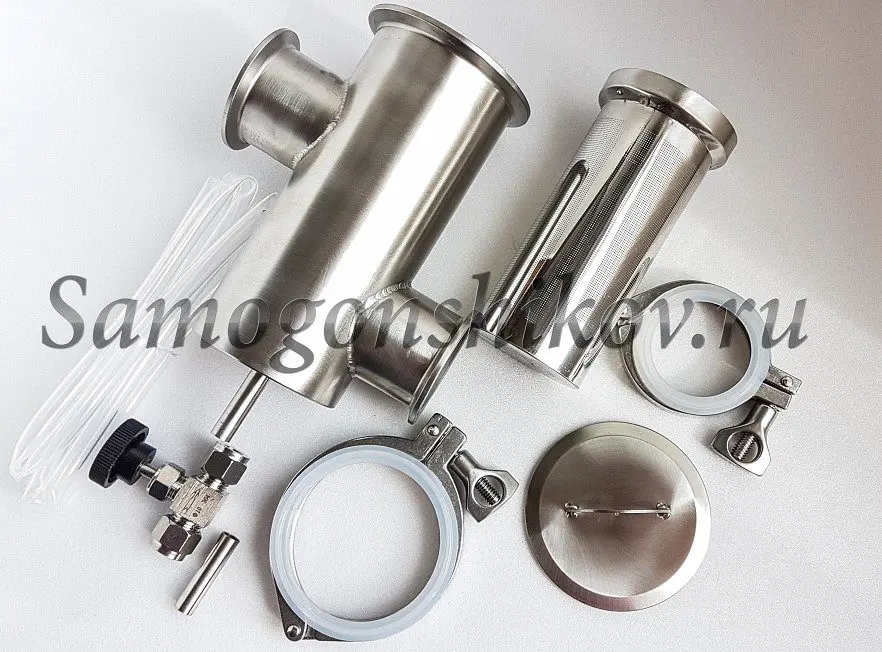
conclusions
- Distiller CC-2 PRO meets the specifications declared by the manufacturer. This is a column-type moonshine still with reinforcement.
- Although the column is on the verge of its capabilities, but when using the SPN packing, it can support the technology adopted for high purification of distillate at BK and RK.
- When using the on-load tap changer, the power and throughput of the reflux condensers are insufficient for stable operation of the column in the pre-choke power mode and the maximum number of separation stages. But when distilling fruit or grain brews on this apparatus, you can get quite a decent result.
The main disadvantage of the apparatus is its dephlegmator. The transition to large diameter steam pipes could significantly expand the capabilities of the product.
- Distillation stills based on Chinese LuxStahl boilers are noteworthy for their assortment, rich components and workmanship.
- Additional components are original and worth the money.
- Control electronics is clearly a weak side of the manufacturer, it is better to look for this module on the side.
- The manufacturer honestly positions its products, which inspires confidence.
Reviewed by IgorGor.









